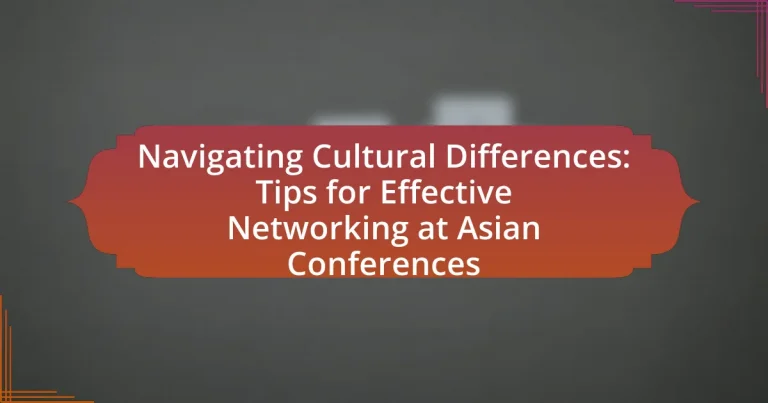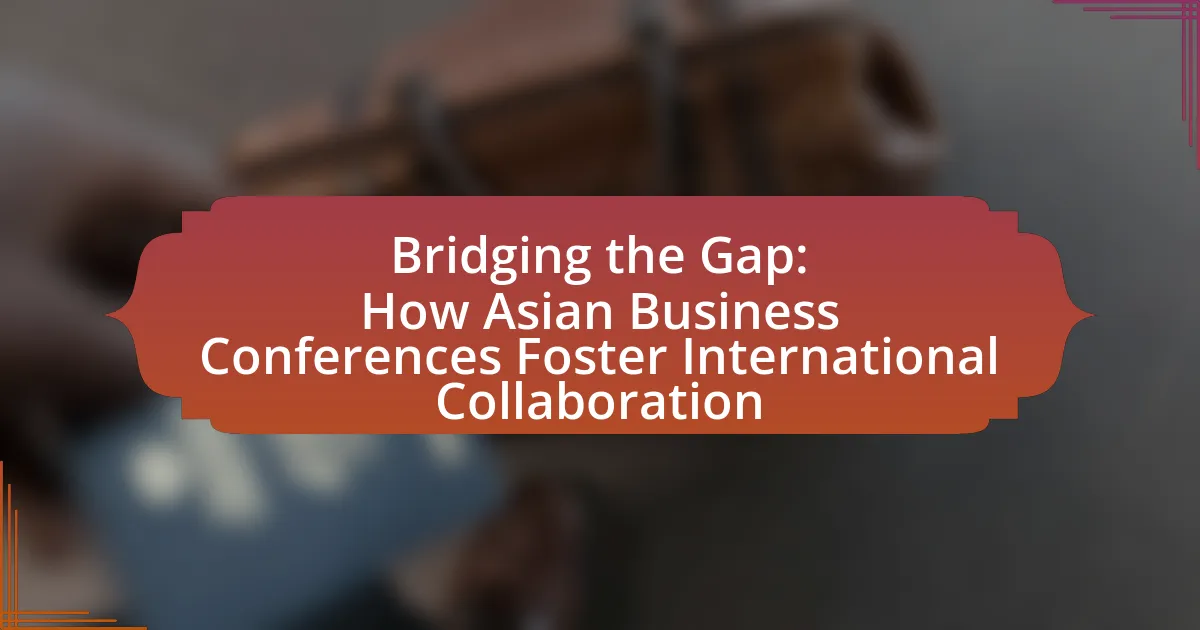The article focuses on navigating cultural differences to enhance networking effectiveness at Asian conferences. It highlights key cultural aspects such as varying communication styles, hierarchical structures, and the importance of relationship-building. The discussion includes insights into direct and indirect communication preferences across different Asian countries, the role of non-verbal communication, and common etiquette practices. Additionally, it addresses challenges like language barriers and cultural misunderstandings, while providing practical tips for successful networking, including the significance of shared interests and the concept of ‘face’ in Asian cultures. Overall, the article serves as a comprehensive guide for professionals seeking to improve their networking skills in diverse Asian contexts.
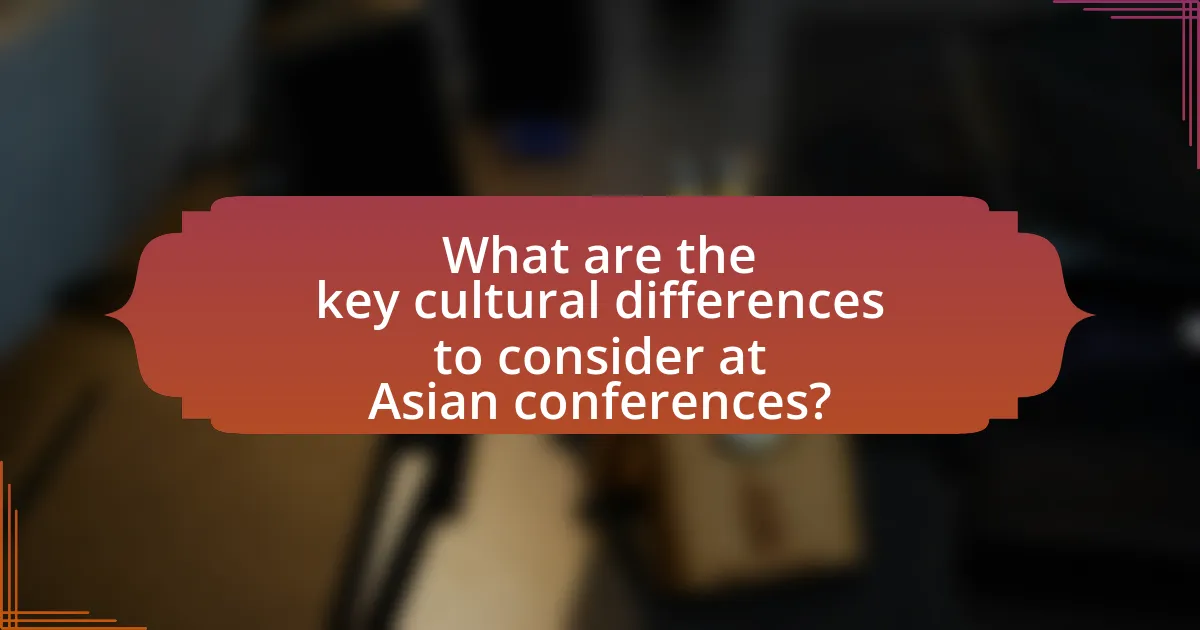
What are the key cultural differences to consider at Asian conferences?
Key cultural differences to consider at Asian conferences include varying communication styles, hierarchical structures, and relationship-building practices. In many Asian cultures, indirect communication is preferred, meaning that participants may use non-verbal cues or subtle hints rather than direct statements. This contrasts with more direct communication styles found in Western cultures. Additionally, hierarchical structures are significant in many Asian societies, where respect for seniority and authority influences interactions; thus, addressing senior members appropriately is crucial. Relationship-building is also essential, as establishing trust and rapport often precedes business discussions, highlighting the importance of networking events and informal gatherings. Understanding these cultural nuances can enhance engagement and foster successful collaborations at Asian conferences.
How do communication styles vary across Asian cultures?
Communication styles across Asian cultures vary significantly, influenced by factors such as collectivism, hierarchy, and context. For instance, in countries like Japan and South Korea, indirect communication is prevalent, where non-verbal cues and context play a crucial role in conveying messages, reflecting a high-context communication style. In contrast, cultures such as those in India may exhibit a blend of direct and indirect styles, often depending on the social context and relationship dynamics. Research indicates that in collectivist societies, maintaining harmony and face-saving is prioritized, leading to more nuanced and subtle forms of expression. This is supported by studies showing that Asian cultures often emphasize group consensus over individual opinion, impacting how messages are framed and delivered.
What are the direct and indirect communication preferences in different Asian countries?
Direct communication preferences vary across Asian countries, with cultures like Japan and South Korea favoring indirect communication, while countries such as India and the Philippines exhibit a mix of both styles. In Japan, indirect communication is preferred to maintain harmony and avoid confrontation, often relying on non-verbal cues and context. South Korea similarly values indirectness, emphasizing respect and hierarchy in communication. Conversely, India displays a more direct approach in urban areas, though indirect communication is still common in rural settings, reflecting a blend of traditional and modern influences. The Philippines tends to favor a direct style, especially in business contexts, but also incorporates indirect elements to preserve relationships. These preferences are shaped by cultural norms, historical contexts, and social structures, influencing how individuals engage in networking and communication at conferences.
How does non-verbal communication play a role in networking?
Non-verbal communication significantly influences networking by conveying emotions, intentions, and cultural nuances without spoken words. For instance, body language, eye contact, and facial expressions can establish rapport and trust among individuals, which is crucial in networking scenarios. Research indicates that 93% of communication effectiveness is determined by non-verbal cues, highlighting their importance in forming connections. In Asian cultures, specific gestures and postures can carry different meanings, making it essential for individuals to be aware of these subtleties to avoid misunderstandings and foster positive interactions.
What are the common etiquette practices in Asian networking?
Common etiquette practices in Asian networking include showing respect through formal greetings, using both hands when exchanging business cards, and maintaining a polite demeanor. In many Asian cultures, such as Japan and China, bowing or a slight nod is customary when greeting someone, reflecting respect and humility. The exchange of business cards, known as “meishi” in Japan, is a significant ritual; cards should be presented and received with both hands, and one should take a moment to examine the card before putting it away, signifying respect for the individual. Additionally, maintaining a calm and composed demeanor is essential, as emotional restraint is often valued in professional interactions. These practices are rooted in cultural values that emphasize respect, hierarchy, and relationship-building, which are crucial for successful networking in Asian contexts.
How important is the concept of ‘face’ in Asian cultures?
The concept of ‘face’ is extremely important in Asian cultures, as it directly influences social interactions and relationships. ‘Face’ refers to an individual’s social standing, reputation, and dignity, which are crucial for maintaining harmony and respect within communities. In many Asian societies, such as China, Japan, and Korea, preserving face can dictate behavior in both personal and professional contexts, often leading to indirect communication styles to avoid confrontation or embarrassment. Research indicates that in collectivist cultures, the need to maintain face can significantly impact decision-making and conflict resolution, highlighting its central role in social dynamics.
What are the typical greetings and introductions in various Asian cultures?
Typical greetings and introductions in various Asian cultures vary significantly. In Japan, a common greeting is a bow, which reflects respect, while in China, a handshake is typical, often accompanied by a slight nod. In India, greetings often involve saying “Namaste,” accompanied by pressing palms together. In Thailand, the “wai” gesture, where hands are placed together in a prayer-like position, is customary. These practices are rooted in cultural values; for instance, bowing in Japan signifies humility and respect, while the “wai” in Thailand emphasizes politeness and reverence. Understanding these greetings is essential for effective networking at Asian conferences, as they demonstrate cultural awareness and respect.
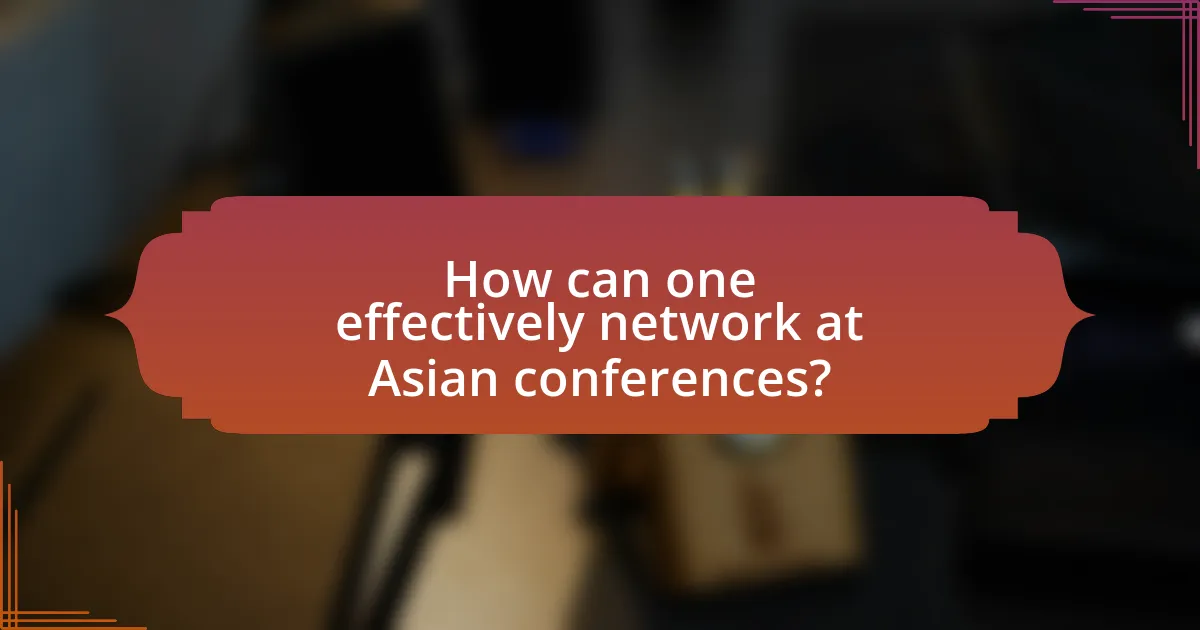
How can one effectively network at Asian conferences?
To effectively network at Asian conferences, one should prioritize building genuine relationships through respectful communication and cultural awareness. Engaging in small talk, understanding local customs, and showing interest in attendees’ backgrounds fosters trust and rapport. Research indicates that personal connections are highly valued in many Asian cultures, making it essential to invest time in conversations rather than solely focusing on business objectives. Additionally, utilizing social media platforms like WeChat or LinkedIn can enhance follow-up interactions, as these tools are widely used in various Asian countries for professional networking.
What strategies can enhance networking opportunities?
To enhance networking opportunities, individuals should actively engage in cultural awareness and adaptability. Understanding cultural nuances can significantly improve interactions, as demonstrated by research from the Journal of International Business Studies, which highlights that culturally aware individuals are more successful in establishing connections. Additionally, attending industry-specific events and utilizing social media platforms like LinkedIn can facilitate introductions and foster relationships. According to a study by the Pew Research Center, 70% of professionals find networking through social media to be effective in building connections. Engaging in follow-up communications after initial meetings also strengthens relationships, as noted in a report by the Harvard Business Review, which states that consistent follow-up increases the likelihood of collaboration.
How can one prepare for networking events in advance?
To prepare for networking events in advance, individuals should research the event’s attendees, speakers, and topics to identify key contacts and relevant discussions. This preparation allows for targeted conversations and enhances the likelihood of meaningful connections. According to a study by the Harvard Business Review, effective networking is significantly influenced by prior knowledge of participants, which can lead to more productive interactions. Additionally, practicing an elevator pitch and preparing questions can facilitate smoother introductions and discussions, further increasing networking success.
What role does social media play in networking at conferences?
Social media plays a crucial role in networking at conferences by facilitating real-time communication and connection among attendees. It allows participants to share insights, engage in discussions, and promote their presence, thereby enhancing visibility and interaction. For instance, platforms like Twitter and LinkedIn enable users to follow event hashtags, join conversations, and connect with speakers and other attendees, which can lead to meaningful professional relationships. According to a study by Eventbrite, 80% of event attendees use social media to connect with others before, during, and after events, highlighting its significance in modern networking practices.
How can one build rapport with Asian colleagues?
To build rapport with Asian colleagues, one should prioritize understanding and respecting cultural nuances. This involves actively listening, showing humility, and engaging in small talk about non-work-related topics, which is often valued in many Asian cultures. For instance, research indicates that in countries like Japan and China, building personal relationships is crucial before discussing business matters, as trust is a foundational element in professional interactions. Engaging in shared meals or social activities can also enhance rapport, as these practices foster a sense of community and connection.
What are effective ways to establish trust in professional relationships?
Effective ways to establish trust in professional relationships include consistent communication, demonstrating reliability, and showing respect for cultural differences. Consistent communication fosters transparency, allowing parties to share expectations and feedback openly. Demonstrating reliability through meeting deadlines and fulfilling commitments reinforces dependability, which is crucial for building trust. Additionally, showing respect for cultural differences, particularly in diverse settings like Asian conferences, enhances mutual understanding and respect, further solidifying trust. Research indicates that trust is significantly influenced by interpersonal interactions and cultural sensitivity, highlighting the importance of these strategies in professional networking.
How can shared interests facilitate networking?
Shared interests facilitate networking by creating common ground that encourages interaction and relationship building. When individuals share interests, they are more likely to engage in meaningful conversations, which can lead to collaborations and professional opportunities. Research indicates that networking effectiveness increases when participants find mutual topics to discuss, as it fosters trust and rapport. For instance, a study published in the Journal of Business Research found that shared interests significantly enhance networking outcomes by promoting a sense of belonging and increasing the likelihood of follow-up interactions.
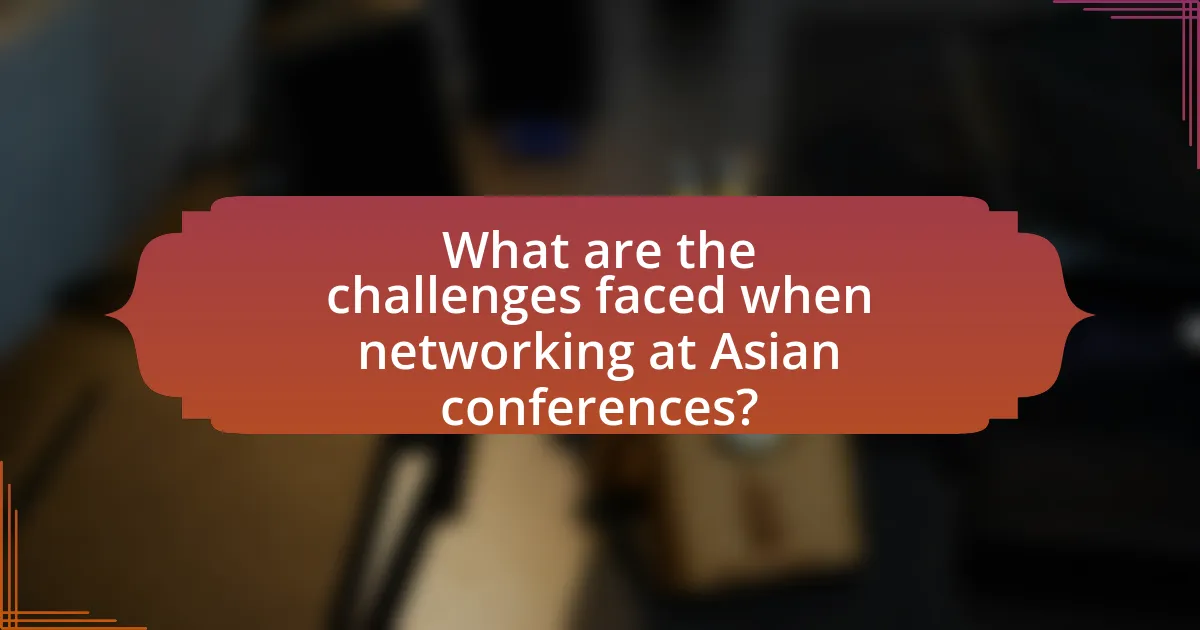
What are the challenges faced when networking at Asian conferences?
Networking at Asian conferences presents challenges such as cultural differences, language barriers, and varying communication styles. Cultural differences can lead to misunderstandings in social interactions, as norms around hierarchy and formality vary significantly across Asian countries. Language barriers often hinder effective communication, making it difficult for attendees to express ideas or engage in meaningful conversations. Additionally, varying communication styles, such as indirect versus direct approaches, can create confusion and affect relationship-building efforts. These challenges are supported by research indicating that cultural context plays a crucial role in networking effectiveness, highlighting the need for awareness and adaptability in diverse environments.
What misunderstandings can arise from cultural differences?
Misunderstandings that can arise from cultural differences include misinterpretations of communication styles, differing social norms, and varying perceptions of time. For instance, direct communication is valued in many Western cultures, while indirect communication is often preferred in Asian cultures, leading to confusion in interactions. Additionally, social norms regarding hierarchy and respect can differ significantly; in some cultures, addressing senior individuals by their titles is crucial, while in others, a more casual approach is acceptable. Furthermore, perceptions of time can vary, with some cultures adhering strictly to schedules, while others may prioritize relationships over punctuality. These differences can lead to miscommunication, frustration, and ineffective networking at conferences.
How can language barriers impact networking efforts?
Language barriers can significantly hinder networking efforts by creating misunderstandings and limiting effective communication. When individuals cannot communicate fluently in a shared language, they may struggle to convey their ideas, intentions, and professional qualifications, which can lead to missed opportunities for collaboration. Research indicates that 70% of professionals believe that language barriers negatively affect their ability to network effectively, as highlighted in a study by the British Council. This study emphasizes that clear communication is essential for building relationships and trust, both of which are critical components of successful networking.
What are the potential pitfalls of assuming cultural norms?
Assuming cultural norms can lead to misunderstandings and ineffective communication. When individuals rely on their own cultural frameworks, they may misinterpret behaviors, gestures, or expressions that differ from their expectations. For instance, in many Asian cultures, indirect communication is often preferred, and assuming directness can be perceived as rudeness. This misalignment can result in strained relationships and missed networking opportunities. Additionally, stereotypes may arise from these assumptions, leading to biased judgments about individuals based on their cultural background rather than their personal attributes. Such pitfalls highlight the importance of cultural awareness and adaptability in diverse settings.
How can one overcome these challenges?
To overcome challenges in navigating cultural differences at Asian conferences, one should actively engage in cultural awareness and adaptability. Understanding the specific cultural norms and communication styles of the attendees can significantly enhance networking effectiveness. For instance, research indicates that in many Asian cultures, building relationships through indirect communication and showing respect for hierarchy is crucial. Engaging in active listening and demonstrating patience can foster trust and rapport, which are essential for successful networking. Additionally, participating in pre-conference workshops or cultural training sessions can provide valuable insights into local customs and etiquette, further aiding in overcoming these challenges.
What resources are available for learning about cultural differences?
Books, online courses, and cultural workshops are valuable resources for learning about cultural differences. Notable books include “The Culture Map” by Erin Meyer, which provides insights into cross-cultural communication, and “Hofstede’s Cultural Dimensions” by Geert Hofstede, which offers a framework for understanding cultural variances. Online platforms like Coursera and edX offer courses on intercultural communication, while organizations such as the Intercultural Communication Institute provide workshops and training sessions focused on cultural awareness. These resources are widely recognized for their effectiveness in enhancing understanding of cultural differences.
How can one seek feedback to improve networking skills?
To seek feedback for improving networking skills, one can actively request input from peers and mentors after networking events. Engaging in conversations with individuals who observed your interactions allows for specific insights into your communication style and effectiveness. Research indicates that feedback from diverse sources enhances skill development, as it provides varied perspectives on your approach. For instance, a study published in the Journal of Applied Psychology found that receiving constructive feedback significantly improves interpersonal skills, which are crucial for effective networking.
What practical tips can enhance networking success at Asian conferences?
To enhance networking success at Asian conferences, individuals should prioritize building relationships through respectful communication and cultural awareness. Engaging in small talk before discussing business topics is crucial, as it fosters trust and rapport, which are highly valued in many Asian cultures. Additionally, understanding and respecting local customs, such as the importance of hierarchy and group consensus, can significantly improve interactions. For instance, in countries like Japan and China, addressing senior members first and showing deference can lead to more fruitful connections. Furthermore, utilizing business cards effectively, by presenting them with both hands and taking a moment to examine the card received, demonstrates respect and professionalism. These strategies are supported by research indicating that relationship-building is a key component of successful networking in Asian contexts, where personal connections often precede business transactions.
